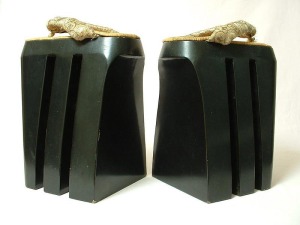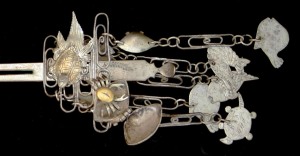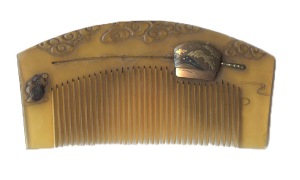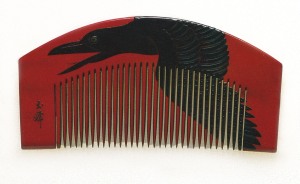Oiran or Japan’s highest ranking courtesans were the grandest and most spectacular women of the “floating world”. The word oiran means “first flower” which poetically indicates their exalted status in society. Like geisha they often had humble beginnings, and many were originally sold into the business as children and were left to work their way up over the years as apprentices. Oiran should not be confused with geisha whose dress was more subtle and simple. Oiran, known for their beauty, artistry and intelligence, dictated the fashions of the day and influenced many artists, poets and musicians. They are part of Japan’s cultural legacy and the famous oiran parade called the “oiran-dochu” is still re-enacted in Japan today. An oiran’s costume consists of many layers of thick padded kimonos along with a large ornate brocade obi tied in the front as was required in her profession. (Kimonos traditionally are tied in the back). She wore towering black lacquer geta which caused her to require assistance to walk. Her hair was arranged in an elaborate hair style with large hair ornaments artfully placed, displaying her rank and status. Objects worn by the oiran are hard to find these days, but I was lucky enough to obtain some of these tortoise pieces as well as this amazing pair of black lacquer shoes from the early 1900’s. One can only imagine the stories these pieces have to tell!
Category Archives: Kanzashi
Crane and tortoise, two major Japanese symbols
Par Creative Museum
Au Japon, deux figures animales associées reviennent très souvent comme motif décoratif. Il s’agit de la grue et de la tortue.
De nombreux kanzashi en sont ornés mais on les retrouve aussi sur les miroirs, les broderies des kimonos ou des ‘fukusa’ (carré de soie pour envelopper un cadeau) et sur beaucoup d’autres accessoires.
La Grue et la Tortue représentent les deux aspects complémentaires et radicalement opposés de l’univers : l’oiseau est le symbole de la liberté dans le ciel et du détachement de l’esprit face aux événements de la vie ; la tortue est le symbole de l’attachement à la terre et de la stabilité du monde.
On peut se demander pourquoi un manteau d’algues est toujours accroché à sa queue. Cela s’explique par une très ancienne légende qui raconte qu’une tortue, Minogamé, vit depuis 10 000 ans au fond des eaux, traînant derrière elle un lourd écheveau d’algues fixé à sa carapace.
Par ailleurs la grue tout comme la tortue vivent très longtemps, De ce fait, elles symbolisent ensemble la longévité et le bonheur et sont donc souvent représentées sur les kanzashi de mariage.
Please see comment #2 for the English translation.
Silver Kanzashi
The kanzashi’s original purpose was a charm against evil spirits. The tradition began as early as 1000 BC to 300 AD, in Japan’s Jomon Era. Decorating them with flowers invited deities. The art captured the Japanese cultural imagination in the Edo era (1603 – 1867), when criminal activity increased. This initiated laws that prohibited people from going out in hats or head coverings, so hairdressing once again came to the forefront of Japanese fashion.
There are many different kinds of kanzashi:
- Mimikaki: an ear pick on the end.
- Tama: decorated with a single coral or jade ball. However now, many materials are used.
- Hirauchi: a flat silver circle decorated with flowers or symbols
- Hana: strings of dangling flowers, worn by geishas
- Bira Bira: fans with long dangling chains, which have ornaments at the bottom
The most interesting ones have unique elements, either as a single decoration or a set of concepts. I’d like to feature three today, one each, from my collection, The Miriam Slater Collection, and The Creative Museum.
My bridal kanzashi is decorated with Mino-Kame — a straw raincoat, which used to be worn before the invention of textiles; a tortoise and pine boughs for longevity; a scroll of wisdom; a treasure box; and flowers, indicating nobility.
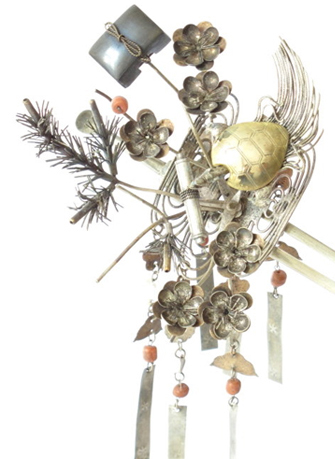
Miriam’s kanzashi is unique. A man with a fishing pole sits on a curved leaf structure, surrounded by dangling chains.
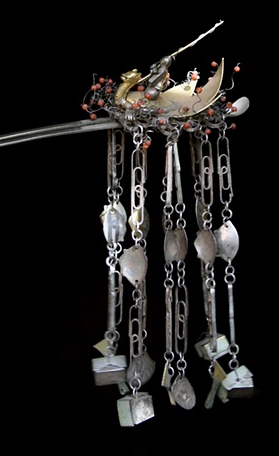
Finally, the Creative Museum has one I absolutely love: a gold fish, whose face looks almost human.
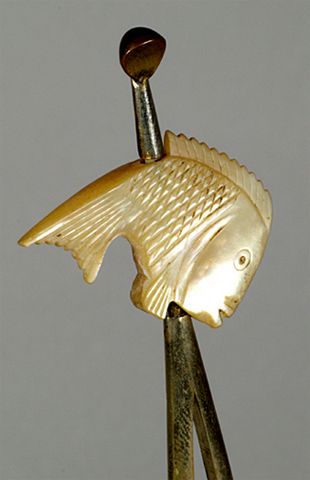
Poetry and symbolism in Japanese kanzashi
By Miriam Slater:
The Japanese over the centuries have distinguished themselves by their cultivation of humor, fine design and poetry within their art. In fact, these qualities are what originally attracted me to kanzashi. As an artist I found myself entranced by the variety of expression within these beautifully crafted pieces.
Metaphors and symbols are commonly seen in Japanese hair ornaments. For example, in the top image, a silver hair ornament depicts a clamshell, a symbol that can also suggest a woman in the Floating World. When opened up, to the viewer’s surprise, in the shell is a small gold crab, pinchers ready!
The second ornament (of a similar theme) features a closed clamshell and a knife used to pry open clams. The clam’s moveable parts will open to reveal the prize within, a pearl. Symbolic objects are frequently seen on kanzashi which enhance the expression and meaning of each piece. The tortoise comb with a fishing rod can be seen as a metaphor for flirting and courtship with its implied hooking and the reeling in of one’s “catch”.
The crow, a common bird that is noisy and known for its bad manners, graces a red lacquer hair comb as an elegant adornment for a woman of position and beauty. The juxtaposition of what is considered ugly played with utmost beauty reflects the poetic side of the Japanese culture. So, to thoroughly enjoy and understand kanzashi, it really helps to see them not only as finely crafted functional objects, but also as works of art imbued with more subtle meanings.
Ebay Dealer Mistakes
There have been many lovely combs on the American, British, and French E-bay sites. However, some dealers misidentify their comb’s country of origin. Here are two examples. Please see item #130476761205.
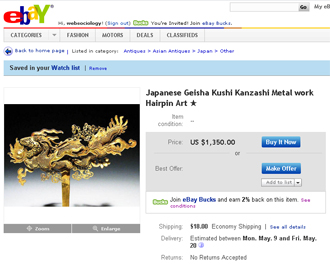
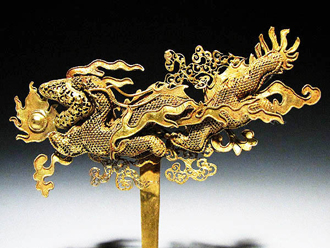
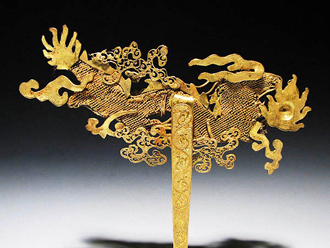
The hairpin is stunning, condition excellent, no arguments that it would be a wonderful piece for any collection. There’s only one problem. It’s a Chinese gold-filigree ornament from the Qing Dynasty (1644 – 1911). According to research from the Creative Museum, “During the Qing Dynasty, many jewels were made of gold-wire filigree. (See book “Gems of Beijing Cultural Relics Series” published by Beijing Publishing House, page 221 – ISBN: 7-200-04899-2)” Here is a picture of their Qing hairpin:
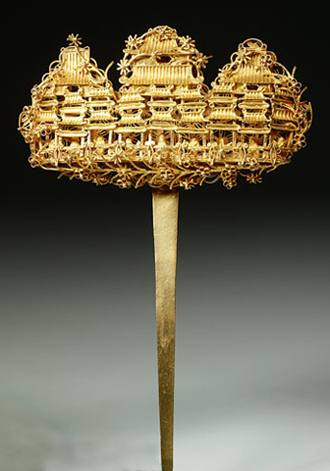
The second misidentified comb did not sell. Please see item #160568156596.
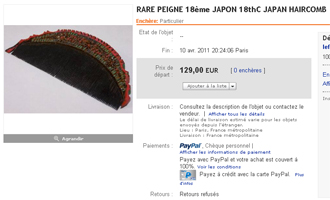
Another lovely piece, but again, it’s not Japanese. It’s from the Punjab Region of Pakistan. The Creative Museum has a gorgeous one with beads, pearls, wood indentations, and a fish theme.
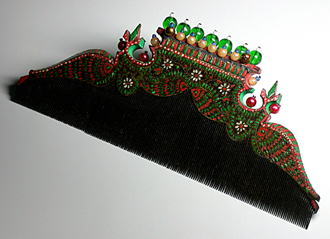
This kanzashi IS Japanese. It’s gorgeous. Please refer to item #280637283941. It’s going for $725, but the seller is accepting offers.
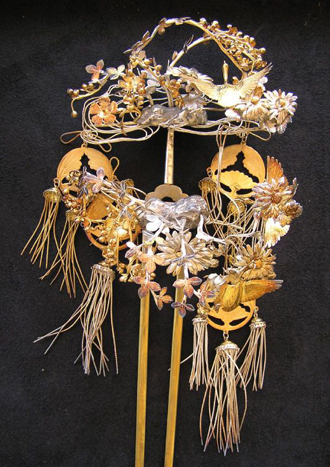
Kanzashi as Deadly Weapons
Brass- or gold-plated metal kanzashi began to be made in the latter part of the Edo era, when hair styles became more complicated. Hair ornaments revealed a woman’s class, marital status, age, and if she had any children.
A woman could also use her kanzashi as a deadly weapon. Female ninja, or kunoichi, practiced ninjutsu, the martial art of guerrilla warfare. They used their kanzashi to rake the eyes of their victims while escaping. Or, they dipped them in poison to assassinate people. Fending off male attackers was another convenient function.
This gold-plated skull kanzashi subtly illustrates beauty’s deadly side. It currently resides in the Daruma Museum
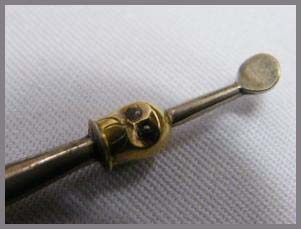
I bought this
Set of two Meiji tortoiseshell kanzashi with plovers on them. The last two shell kanzashi I bought arrived broken. Let’s hope the third one’s the charm! lol I paid a whopping $77 for them on ebay. I love the seller, though. She’s a superb collector.

Broken Kanzashi, Broken Heart
Recently, I bought a real shell kanzashi for $214.50. Given the prices Japanese combs are going for on ebay now, I was thrilled to get a real shell kanzashi for a price I could afford. I begged the seller to wrap it properly. I told her a story of when I paid $600 for a real shell kanzashi from Kyoko at Trocadero. It was of a bat. She wrapped it in an envelope, and it came broken. I haven’t been able to find one I liked for what I could afford since then, maybe 3 years ago. Here is what I bought. Shipping cost for me? $14.
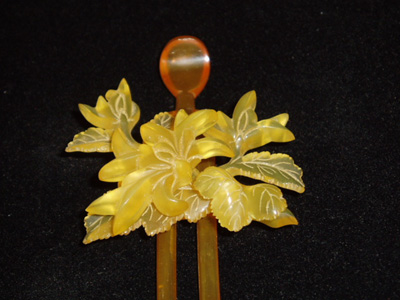
Here is how it arrived: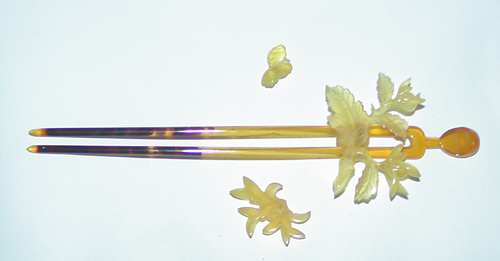
For $14 shipping, it was sent in the smallest-sized priority mail box, wrapped in a few sheets of bubble wrap, with a few popcorn things, and the actual piece was wrapped in what I believe is toilet paper. Sure, I’ll send it back and get a refund, but what the ****. Toilet paper? And a small box, when I begged them? I am just so furious at this moment I could scream. It was a beautiful art piece that survived 100 years in tact. Now, it’s ruined.
The One That Got Away
I saw it listed at $9.99, 6 days to go. It was a drop-dead gorgeous real shell kanzashi with coral. I thought it was real, anyway. My eyes popped out of my head. I emailed two of my friend collectors. “Are you going for this?” “Do you think it’s real?” The coral is too pink, but it looks real. All of us thought it was real, so I put a large snipe bid on it.
I thought to myself, I could write to this person, ask them to end the auction, play games, but I just am not in that space anymore. The grab, the manipulation of someone who doesn’t know as much as you, the seduction to get the coveted item at a low price.
The whole dance makes me vomit. I couldn’t do it, but I saw this seller’s vulnerability. I mean she was the kind of n00b, who lists a priceless piece and then makes sure people know they don’t get the pillow it’s pictured on as a part of the auction. I am going to value this at around $700. A similar pair of shell kanzashi went for $890 on Trocadero, recently. Comments welcome if you disagree.
In addition to listing it at $9.99 with no reserve, this seller stated she didn’t know what she was doing, that her father left this to her, which means he gave it to her with love, which means it’s real, which means… The (0) next to her name told us it was the first time she was listing on ebay. She was bait for the vultures. I put a snipe bid on it that reflected what I thought was its real value and said nothing.
One day before auction end, the item was gone. Someone wrote to her and convinced her to sell them the item off ebay. I don’t know what they said. I don’t know what kind of value she got. I hope she wasn’t a meal for some dealer, and we don’t see this piece on someone’s site going for full value in the near future. If we do, then I guess we’ll know who the vulture was.
And then the question for all collectors becomes, you either win the game or you don’t. You either get the coveted piece or you don’t. Do you want to do what it takes to win? What will it do to you as a human being? It’s not in me anymore. So ah well, the one that got away.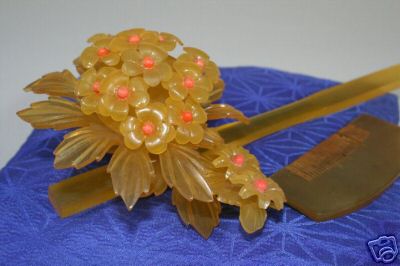
Well, you had to wear them in something
Here are some 19th-century paintings of Geishas in their wigs, wearing the beautiful ornaments we all admire. It’s nice to see kushi and kanzashi in context. From the historical record these paintings provide, it looks like the wigs were just as creative as the combs.
Geisha with Sake Cup, by Keisai Yeisen (1789-1851)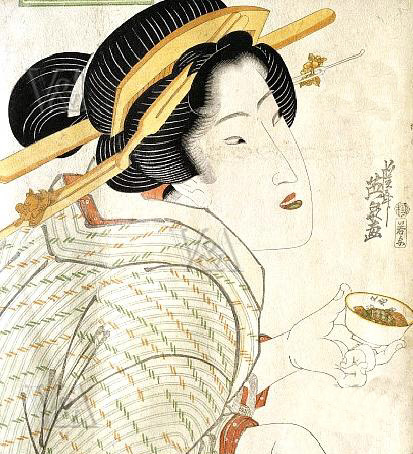
Courtesan with a fan, by Kitagawa Utamaro (1753-1806)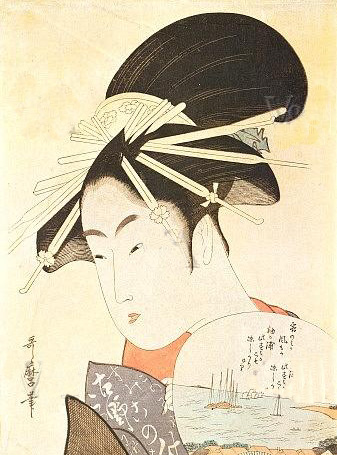
The Doll’s Festival, from the Furyu Goyo Matsu (Five Seasonal Festivals) Series, by Torii Kiyomitsu II (Torii Kiyomine) (1788-1868)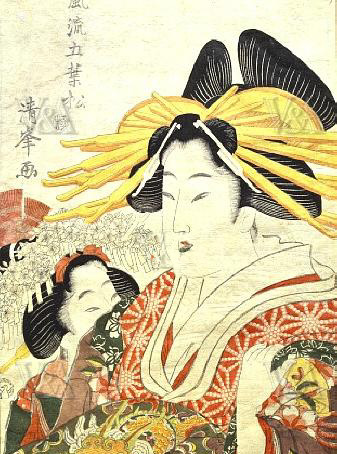
Beauties of the Yoshiwara at Daikoku House, by Keisai Yeisen (1789-1851).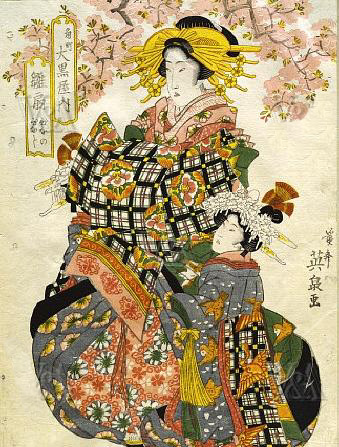
And on a BA-Life Personal Clutz Note: I’m glad my Japanese combs are in a case. Can you imagine balancing in one of those wigs, knowing you have these priceless tortoiseshell ornaments on, and you can’t fall? And the kimonos! Can you imagine walking in that and not falling? Who stopped wearing heels at 40? ;-)


